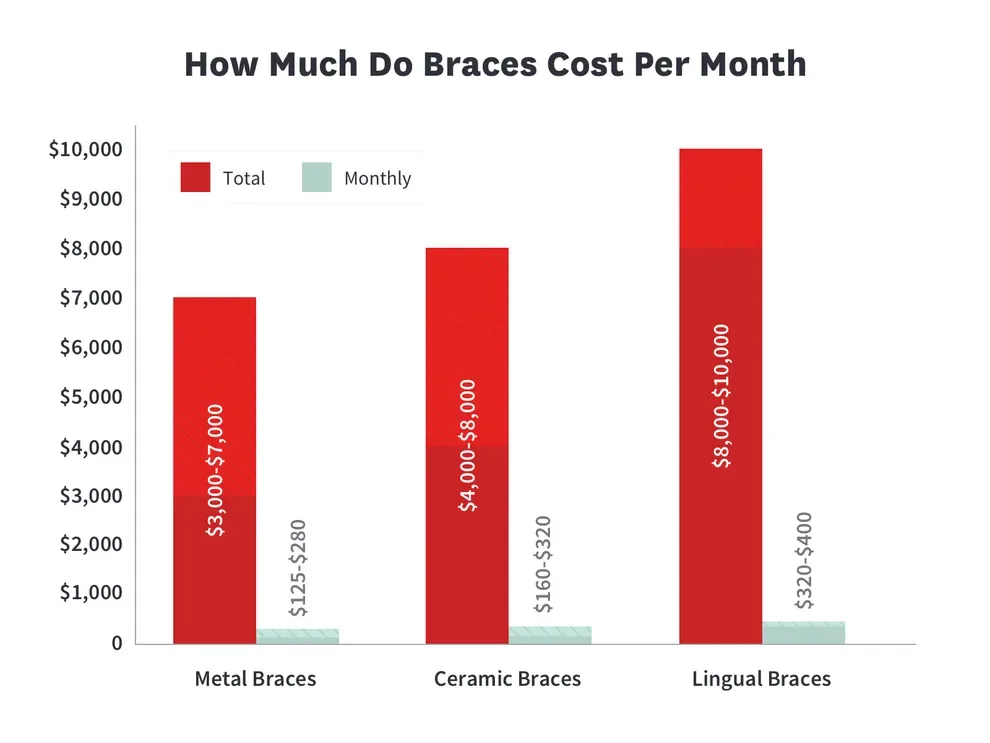Monthly Breakdown of Braces Costs: Is It Worth It?

Table of Contents
- Average Cost of Braces Per Month
- Cost of Braces Monthly with Insurance
- Factors that Affect Price
- Financing Options
- Comparing Costs to Aligners
- Comparing the Cost of Different Types of Braces & Aligners
- What’s the Best Way to Compare Fees?
The average cost for traditional metal braces is around $6,000. For an average treatment time of 24 months, this could mean a monthly fee of around $250 before any insurance co-payments or financing fees.
Braces pricing varies dramatically from one mouth to another, and some professionals tack on fees that add to your overall cost. Families that don't read the fine print could end up with unexpected bills that they struggle to pay.
What Is the Average Cost of Braces Per Month?
Most dental professionals discuss total pricing. Rather than quoting you a per-month fee, they'll explain the size of your total bill. A little math can help you break that big fee down into a monthly price.
Expect to pay about $6,000 for metal braces, experts say. Most people wear the devices for 24 months.
$6,000 / 24 months = $250 per month
However, additional treatment fees may apply for any additional needs (like x-rays or damaged braces) as well as additional financing costs.

What Is the Average Cost of Braces Per Month with Insurance?
Will insurance cut the cost? The level of financial help will vary by plan, but it's common for dental insurance policies to include these things:
Exclusions: An exclusion is something that your insurance plan will not cover, even though the rest of your treatment plan might be. Common exclusions in plans that include orthodontic care include ceramic brackets.
Deductibles: A deductible is a set amount of money you must pay until your benefits kick in. Until you pay your deductible, the insurance company won’t pay.
Copayments: The amount you’re asked to pay when you do things like attend an appointment.
Maximums: The limit your insurance plan sets for care. If your treatment costs more, your insurance may not pay for it.
Imagine that your dental plan came with these things:
Coverage for metal braces
Exclusions for ceramic braces
$500 in deductibles
50% copays
A $2,000 maximum amount of coverage
If your total braces cost is $6,000, you'll get about $2,000 of help. That cuts your remaining bill by quite a bit, but you will still have fees to cover.
$4,000 / 24 months = $167 per month
If you opt for ceramic braces, your insurance company may not pay anything at all, as this type of care is excluded.
Factors That Affect the Price of Braces Per Month
Looking at average costs can help you to get an idea of the monthly cost of braces, but there are also factors you should consider when trying to estimate the monthly price of your treatment. These include the following:
The type of braces you’re getting: Metal “traditional” braces are the most affordable of braces options. Ceramic braces (with clear or tooth-colored hardware) are generally a bit more expensive. Lingual braces, which attach to the back of the teeth, are the most expensive option.
Financing fees: Payment plans through an orthodontist office or third-party provider may charge you considerable fees for financing. Be sure you understand the terms and shop around before agreeing to a payment plan.
Orthodontic appliances and accessories: Devices like headgear and palate expanders may be used to correct your bite, and they may come with additional fees.
Your orthodontist: Some specialists charge extra for additional licenses or training. Comparing one practitioner with others in the area can give you an idea of whether or not you’re paying an unnecessary premium.
Unexpected fees: Before beginning treatment, go over all anticipated out-of-pocket costs with your orthodontists. Check your monthly bills or invoices to ensure there aren’t any surprises.
Financing Options to Help Pay for Braces
Braces are expensive, and some providers offer monthly payment plans that can help you manage the cost of care.
Some dental and orthodontic practices offer low or even 0% financing to their patients. Others charge a hefty fee or use a costly third-party credit provider.
In some cases, a low-APR personal loan or credit card may be a better option to pay for braces, especially if your orthodontist offers a discount for paying in full.
Comparing the Cost of Braces to Teeth Aligners
Aligner companies like Byte are different. These organizations use innovative technology to move teeth while eliminating appointments and hidden costs. Everything is bundled into one monthly fee that includes the following:
A treatment plan that is designed and monitored by professionals.
A series of clear aligners that will move your teeth to optimize your smile.
HyperByte® that gently vibrates your teeth to shorten treatment times.
A sample of BrightByte™ for whiter teeth.
Medical-grade retainers to protect your smile after treatment.
A lifetime guarantee.
With BytePay™, you'll have a bill of $89 per month for 36 months. The financing comes with a 100 percent approval rating, and your credit can be checked without impacting your credit score.
If monthly payments aren't right for you, you may choose to cover the total cost of $2,099 in one single payment. That's still remarkably less than the competition.
Comparing the Cost of Different Types of Braces & Aligners
We’ve already discussed the cost of traditional metal braces, including the price with and without insurance. However, other types of devices have different prices and treatment time frames.
Ceramic braces work like traditional metal versions, as brackets sit on the front of your teeth and are connected by wires. However, ceramic versions match the color of your teeth and are harder to see. The materials to make them are more expensive, so they can be more costly than metal versions. Your insurance company may not pay for this option, as it’s a cosmetic choice.
Lingual braces also involve brackets and wires, but the devices are placed on the back of your teeth rather than the front, making them harder to see. The cost for this type of treatment can be higher, as your dental professional needs extensive expertise and more time in each appointment. Your insurance company may not pay for this option as it’s cosmetic.
Dental professionals supervise traditional aligners in a series of in-person appointments. At-home doctor-supervised aligners are different as they do not involve appointments.
This table can help you understand the differences and similarities between these options:
| Cost | Covered by Insurance? | Treatment Time Frames |
Metal braces | $3,000-$7,000 | Sometimes | 12-24 months |
Ceramic braces | $4,000-$8,000 | Rarely | 12-36 months |
Lingual braces | $8,000-$10,000 | Rarely | 18-36 months |
Traditional aligners | $3,000-$7,000 | Sometimes | 12-24 months |
At-home aligners | About $2,000 | Sometimes | 6-18 months |
Once again, your costs can vary dramatically by factors that aren’t always in your control, including the following:
Provider preference: Some doctors charge more than others to cover their expenses for offices and staff.
Geographic location: It’s more expensive to deliver dental care in some parts of the country than others.
Case severity: In general, the more complex your case, the longer treatment might take. Extended periods in care can lead to higher costs.
What’s the Best Way to Compare Fees?
We’ve explained how your costs can vary by the device you use and the insurance coverage you have. You can also look closely at the fees your providers might charge for your specific case.
Many dental professionals offer free initial screening exams. At the end of that visit, you could ask about expected costs. If it’s possible, get a detailed estimate that includes the following information:
Overall cost of your treatment within a specified time frame
How much more you might pay if your treatment takes longer
Your expected costs for damage, like broken brackets or wires
Your costs for retainers (if any)
Any fees associated with your office visits
Whether (or not) your insurance company will pay for this treatment
Use detailed estimates like this to help you compare potential partners. You may decide you’re willing to pay more to work with a specific professional you prefer, but with this data, you can make an informed choice.
Once you’ve chosen your provider and started treatment, you may get a monthly fee for services. It should (obviously) match the estimate you were given. For example, if your dental professional said you would not be charged for your monthly visits and you get a bill, this could be a mistake. Talk to your dental professional and get the issue straightened out as quickly as you can.
